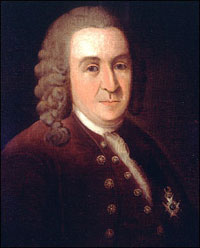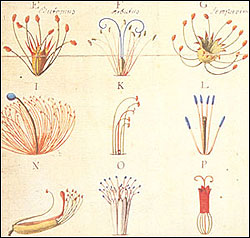What's in a name? A history of taxonomy
By Sandra Knapp
Linnaeus and the birth of modern taxonomy
The ancient Greeks and Romans named and classified organisms, particularly those that were useful to them. They had names for medicinal plants and for the animals they hunted and those that they feared. This tradition was carried on in northern Europe, where the naming of plants was done by herbalists. In 1597 the Englishman John Gerard wrote a herbal, one of the first to be written entirely in the English language, which described the plants that were useful to people in his native land. Amongst these was the potato, which in those days was mistakenly thought to come from Virginia, in the United States--it does in fact come from Peru. The herbal also contained a reference to the tomato, which was known as the love apple, or poma amoris.
This is an example of one of the primary problems of the names of organisms. Names get changed with use--Poma amoris, the love apple, started life either as poma di Mori, the apple of the Moors or poma di ori, the golden apple. Over time, the vernacular name became corrupted to poma amoris, and the tomato was presumed to be a powerful aphrodisiac.
At about the same time, in the late sixteenth century, the science of scientific naming started. Plants and animals were given long, polynomial Latin names. At that time Latin was the language of scholarship--a logical choice for scholarly naming. For example, the humble tomato was given the long Latin polynomial Solanum caule inermi herbaceo, foliis pinnatis incisis which means the 'solanum with the smooth stem which is herbaceous and has incised pinnate leaves.'
In the eighteenth century, people working with plants and animals started trying to name things formally, and to use those names consistently. This became increasingly problematic as diversity increased. Initially, only local organisms were known but as other lands, such as the New World, were discovered and explored, the system became complicated. For example, some of the Jesuit priests who accompanied Pizarro when he conquered the Inca empire decided that there must have been two gardens of Eden because the vegetable productions of the Andes were so very different to those of Spain. Many similar theories abounded at the time because it was difficult to explain the diversity being encountered using the Biblical paradigm.

Carolus Linnaeus (1707-78).
Linnaeus and a new way of naming
In the mid-1700s a young Swedish doctor, Carolus Linnaeus, went on a journey to Lapland. Linnaeus was an ingenious and complicated man, and one of the most arrogant people in the history of science. Later in his life he claimed that 'no man has ever transformed science in the way that I have.' His arrogance was, to a great extent, justified.
Linnaeus was a medical doctor, as were all botanists at that time. Until recently, all medicine had been based on herbalism and doctors had to study botany in order to learn their craft. So botanical taxonomy originated with the need of doctors to identify plants correctly. Linnaeus kept plant specimens in his own herbarium. He was fascinated by plants from all over the world and would often travel to examine other people's collections.
Linnaeus was interested not only in plants but in all living organisms. He collected a huge variety of plants and animals and started looking for a system in nature. He was trying to describe all the things that had been put on Earth by the Creator, and therefore approached taxonomy with the tacit assumption that this task was finite.

Linnaeus's sexual system as drawn by G.D. Ehret (1736).
In the course of his work, Linnaeus did two critically important things for the development of taxonomy. The first was to invent what is known as the sexual system. Instead of looking at the totality of a plant, as would a herbalist, he concentrated on one particular character--and organised all plants according to that character. The characters that he chose were the number of stamens, the male parts, and the number of pistils, the female parts. This was controversial at the time to the extent that he was accused of being a botanical pornographer! His rivals criticised his system as 'loathsome harlotry (scortationes quasi destabiles)'. It was thought that ladies shouldn't deliberately look at the sexual parts of plants. But despite this disapproval the sexual system soon caught on because it was so accessible and straightforward. It represented a democratisation of science in that anyone, not just a specialist, could look at a flower and count the number of male parts and female parts.
In this way Linnaeus made the first of the big advances that transformed the science of taxonomy. The second of his major achievements in this regard occurred by accident. In 1753 he published a book called Species Plantarum which was a list, organised according to the sexual system, of all the plants known to Linnaeus at that time. It was essentially a flora of the world, a field guide to the world's plants. In it he did something that was to completely change the way in which things were named.

Specimen of red maple, Acer rubrum, used by Linnaeus.
The birth of the binomial
Until that time, plants were being named with polynomial, Latin names. As more and more species were being discovered, particularly in the New World, those polynomials were getting longer and increasingly unwieldy. So Linnaeus also assigned a 'trivial name' for each plant, a binomial name with only two parts. The idea was that this trivial name would be easy to remember and would trigger the memory of the plant's 'correct' polynomial name.
The binomial names were so much easier to remember that people soon started using them in place of the 'correct' names. Eventually they replaced the polynomial names completely, and became the correct names. The binomial system is the same one we use today--it's how the scientific names of all organisms are constructed. The first part of the name is called the genus and is always capitalised. The second part of the name is called the species epithet and is not capitalised. In the correct format of a scientific name a person's name (sometimes abbreviated) appears after the genus and species name, and this refers to the person who first coined the name. So the scientific name for the raspberry, Rubus idaeus L., can be broken down like this: Rubus (the genus name) idaeus (the species name) Linnaeus (the botanist who coined the name, often abbreviated). Taxonomists have formulated sets of rules for naming; all botanical naming begins with Linnaeus' Species Plantarum in 1753 and animal naming with his tenth edition of Systema Naturae published in 1759.
Animals often reflect their physical attributes, which is useful in aiding memory and providing a basic description. Sometimes those who attribute the names make mistakes; Solanum arboreum sounds as if it should be a tree, but is in fact a tiny shrub, which grows to only about 18 inches. Linnaeus also gave our own species their name, Homo sapiens, which means 'thinking man'--whether or not this name is appropriate is of course a matter of opinion.
Names are also used to honour people. This practice can sometimes result in cumbersome names; for example the plant Rahowardiana wardiana D'Arcy was named by a mentor of mine, after two of his mentors, R.A. Howard and D.B. Ward. Linnaeus was extremely fond of naming plants after people. He named the genus Magnolia after the French Huguenot botanist Pierre Magnol, whom he greatly respected, while the genus Sigesbeckia, a small creeping herb that grows in mud was named for Linnaeus' main critic, Johann Siegesbeck, with whom Linneaus quarrelled.
Toolbox

In World War II the Museum was used as a secret base to develop new gadgets for allied spies, including an exploding rat!
